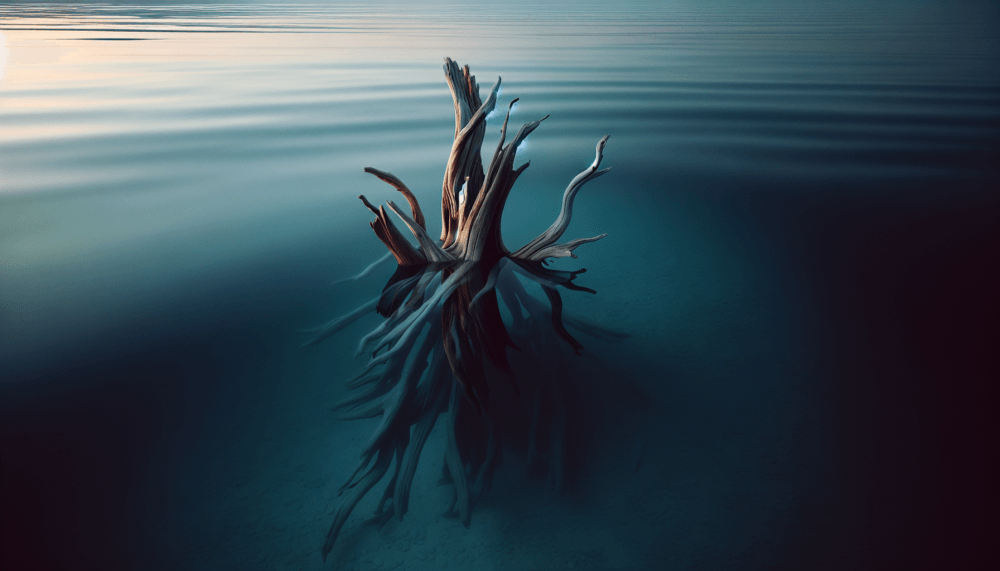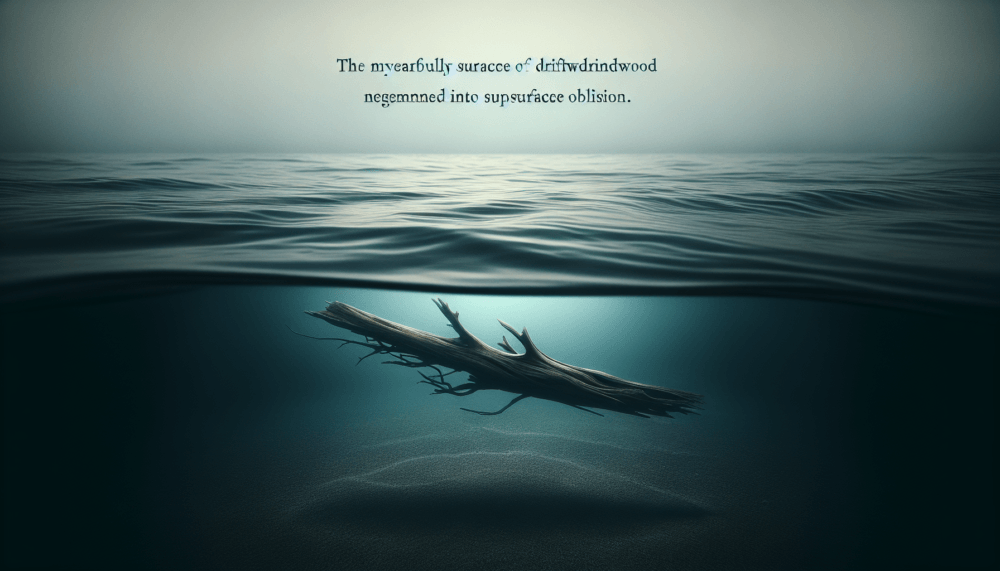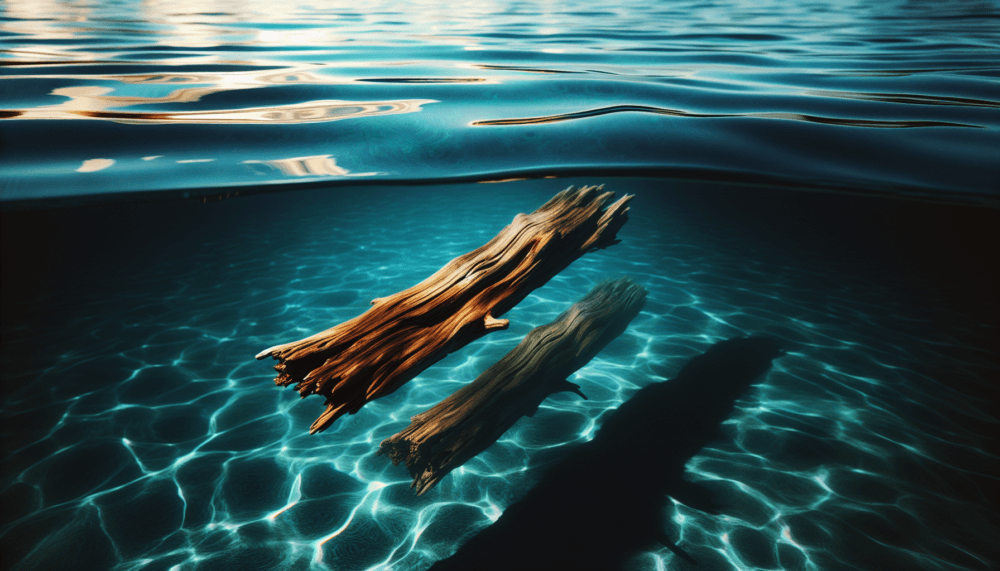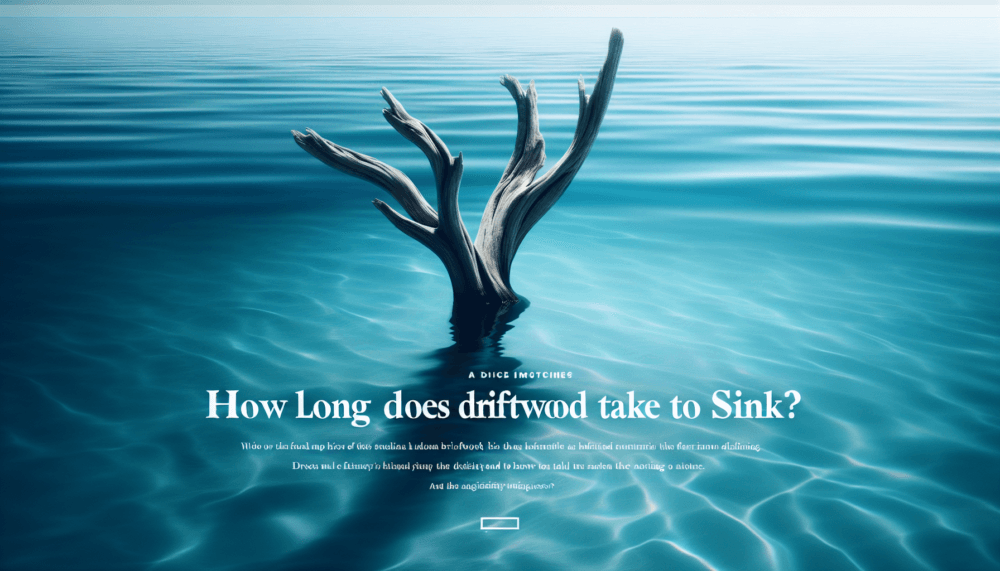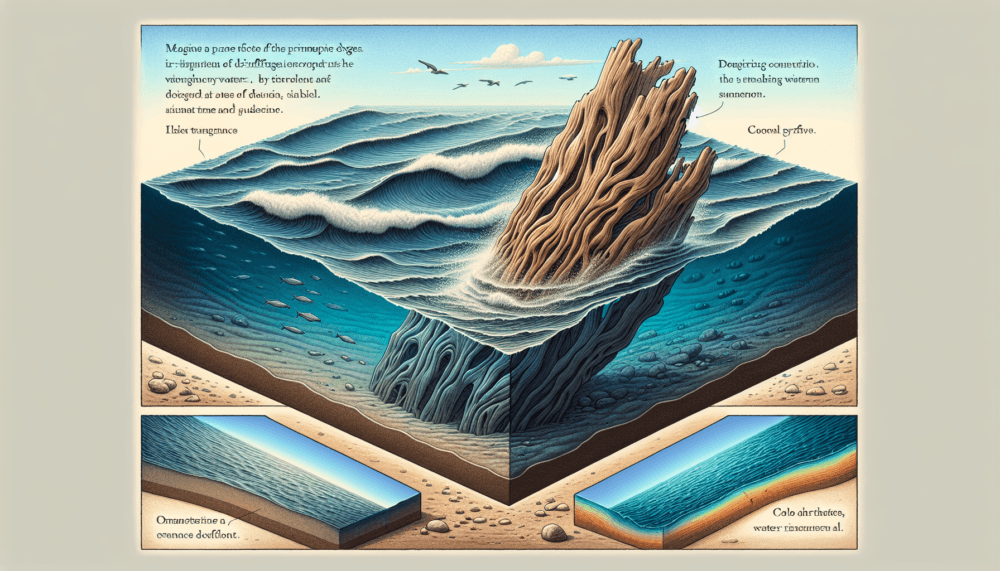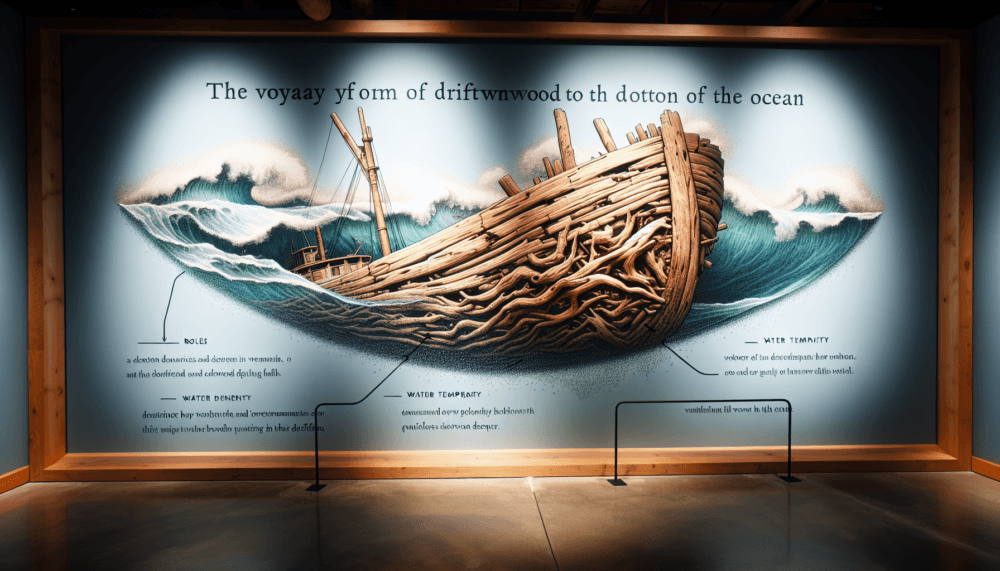Imagine standing on the shore of a tranquil beach, gazing out at the endless expanse of ocean. Your eyes fixate on a piece of driftwood floating lazily on the surface, gently bobbing with the rhythm of the waves. Have you ever wondered how long it takes for that piece of driftwood to eventually descend into the depths of the sea? In this article, we will explore the fascinating journey of driftwood and uncover the factors that determine its ultimate fate beneath the surface. Get ready to dive into the mysterious depths of the ocean as we unravel the enigma of “How Long For Driftwood To Sink?”

Factors Affecting Driftwood’s Sinking Time
Density and Specific Gravity
The density and specific gravity of driftwood play a significant role in determining its sinking time. Driftwood tends to float initially due to its lower density compared to water. However, as the wood becomes waterlogged and absorbs water over time, its density increases, eventually causing it to sink. The specific gravity, which measures the relative density of an object compared to water, also affects the sinking time. Driftwood with a higher specific gravity will sink faster than a piece with lower specific gravity.
Size and Weight of Driftwood
The size and weight of driftwood impact its sinking time as well. Larger and heavier pieces of driftwood are more likely to sink faster due to their increased mass. The surface area of the wood exposed to the water also affects the sinking time. Smaller pieces will have a larger surface area-to-volume ratio, allowing more water to be absorbed and potentially leading to quicker sinking.
Water Temperature
The water temperature in which the driftwood is submerged can influence its sinking time. Warmer water generally accelerates the decay and waterlogging process, as microbial activity and chemical reactions occur more rapidly. Consequently, driftwood submerged in warmer water may sink faster than those exposed to colder temperatures.
Water Salinity
The salinity of the water also plays a role in the sinking time of driftwood. Generally, freshwater has a lower salinity level than saltwater. The higher salt concentration in ocean water affects the buoyancy of driftwood, making it more likely to float. Therefore, driftwood submerged in saltwater may take longer to sink compared to those immersed in freshwater.
Water Currents
Water currents can greatly affect the sinking time of driftwood. Strong currents will continually push the wood, hindering its ability to absorb water and ultimately delaying sinking. Conversely, calm or slow-moving waters provide more opportunities for water absorption, potentially leading to quicker sinking times.
Types of Driftwood
Hardwood Driftwood
Hardwood driftwood is derived from deciduous trees such as oak, maple, and beech. It is known for its durability and slower decay rate compared to softwood. Due to its dense nature, hardwood driftwood tends to have a higher specific gravity, which aids in its sinking process. Additionally, hardwood driftwood has a more robust and intricate appearance, making it a popular choice for aquascaping and enhancing aquarium aesthetics.
Softwood Driftwood
Softwood driftwood is primarily derived from coniferous trees like pine and cedar. It is characterized by its softer texture and faster decay rate compared to hardwood. Softwood driftwood generally has a lower specific gravity, which can contribute to its tendency to float for longer periods. Despite its shorter lifespan, softwood driftwood is still used in aquariums for a natural and rustic look.
Natural Decay Processes
Role of Microorganisms
Microorganisms, such as bacteria and fungi, play a vital role in the natural decay of driftwood. They break down the wood’s complex organic compounds into simpler substances, accelerating the waterlogging process. As microorganisms colonize the wood, they secrete enzymes that aid in the decomposition process, gradually causing the wood to become saturated and sink.
Chemical Decomposition
Chemical decomposition also contributes to the decay of driftwood. Exposure to water and oxygen triggers various chemical reactions within the wood, leading to the breakdown of lignin and cellulose, the main components of wood. This chemical degradation weakens the structure of the wood, making it more susceptible to physical erosion and ultimately enhancing the sinking process.
Physical Erosion
Physical erosion, caused by water movement, further deteriorates driftwood. Collisions with rocks, sand, and other driftwood pieces can wear away the surface, creating cracks and crevices that promote water absorption. Over time, the continuous action of water currents gradually erodes the wood, increasing its weight and density, and eventual sinking.
Artificial Submersion Techniques
Soaking in Freshwater or Saltwater
To expedite the sinking process, driftwood can be soaked in either freshwater or saltwater before being introduced to an aquarium or a water body. Soaking the wood allows it to absorb a significant amount of water, increasing its overall density. The selection of freshwater or saltwater immersion depends on the intended use of the driftwood and the desired aesthetic effect.
Weighting or Anchoring
If driftwood is still buoyant after soaking, weighting or anchoring techniques can be employed to ensure it stays submerged. Weights such as rocks, ceramic, or stainless steel pieces can be attached to the wood to offset its buoyancy and encourage sinking. Alternatively, anchoring the wood to the aquarium or the water body’s bottom using fishing line or specialized anchor systems can also prevent it from floating.
Weathering
Exposing driftwood to the elements and weathering it naturally can aid in increasing its sinking time. By leaving the wood outdoors for an extended period, such as in a dry and sunny environment, the effects of wind, rain, and temperature fluctuations can enhance water absorption and decay. Weathering can help prepare the driftwood for prolonged submersion by expediting the decay processes.

Special Considerations for Aquariums
Preparation for Aquarium Use
Before introducing driftwood to an aquarium, it is crucial to properly prepare it to minimize potential risks. First, the wood should be thoroughly cleaned to remove any dirt, algae, or microorganisms that might have accumulated on its surface. This can be done by scrubbing the wood with a brush and rinsing it in freshwater. Soaking the driftwood for an additional period in freshwater or saltwater can further eliminate any potential contaminants.
Water Parameters
Driftwood can have an impact on water chemistry, so it is important to monitor and maintain appropriate water parameters in the aquarium. As the wood decays, it can release tannins and other compounds, leading to yellowish or brownish discoloration of the water. While this is generally harmless, it can affect the pH level and water hardness. Regular testing and appropriate adjustments should be made to ensure a suitable environment for aquatic life.
Maintenance and Cleaning
Regular maintenance and cleaning are essential for driftwood in aquariums. Over time, algae, moss, or fungi may grow on the wood’s surface, compromising its aesthetic appeal and potentially interfering with the aquarium ecosystem. Light scrubbing with a soft brush or gentle scraping can remove any unwanted growth. It is important to avoid using harsh chemicals or abrasive materials that may damage the wood or harm the aquarium inhabitants.
The Lifespan of Driftwood
How Long Does Driftwood Last?
The lifespan of driftwood can vary depending on several factors, including the type of wood, water conditions, and maintenance. Hardwood driftwood generally lasts longer due to its higher density and slower decay rate. On average, driftwood can last anywhere from a few months to several years. However, it is important to note that driftwood is a natural material and will eventually undergo decay and degradation.
Signs of Decay
It is important to be aware of signs of decay in driftwood to prevent potential issues in aquariums or water bodies. Softening of the wood, foul odors, mold growth, or significant loss of structural integrity are indicators of advanced decay. If any of these signs are observed, it is advised to replace the driftwood to maintain a healthy aquatic environment.
Replacing and Recycling Driftwood
When driftwood reaches the end of its lifespan, or if signs of decay become apparent, it is necessary to replace it. To ensure responsible and sustainable practices, one option is to recycle the old driftwood by repurposing it for crafts or garden ornaments. Alternatively, it can be disposed of properly or utilized as a natural composting material.
Benefits of Sunk Driftwood
Aquatic Habitat Enhancement
Sunk driftwood provides valuable habitat and shelter for various aquatic organisms. It offers hiding places for fish, invertebrates, and other aquatic creatures, creating a more natural and diverse ecosystem within aquariums or water bodies. The presence of driftwood can help reduce stress in fish by providing them with secure spaces to retreat and establish territories.
Natural Decor for Aquariums
Driftwood’s unique forms, textures, and colors make it an excellent natural decoration for aquariums. It creates a visually appealing and realistic representation of aquatic environments. Driftwood can also serve as a focal point or anchor for aquascaping, where plants and other ornaments are arranged around it to create a harmonious underwater landscape.
Functional Use for Aesthetics
Beyond its aesthetic appeal, sunk driftwood serves functional purposes within aquariums. It can provide support for plants and mosses, acting as a substrate for their growth. Additionally, driftwood can enhance water filtration by acting as a surface for beneficial bacteria colonization, thus aiding in the biological filtration process.
Impacts of Driftwood on Aquatic Ecosystems
Alteration of Water Chemistry
The presence of driftwood in an aquatic environment can alter water chemistry to some extent. As driftwood decays, it releases substances such as tannins, lignin, and humic acids into the water. This can lead to a slight decrease in pH level and a softening of water hardness. While these changes are usually well-tolerated by many fish species, it is important to monitor the effects on the overall water chemistry and make adjustments as necessary.
Habitat Fragmentation
In natural water bodies, large amounts of drifting driftwood can obstruct waterflow and create barriers that fragment habitats. This can impact the movement and migration patterns of aquatic organisms, potentially disrupting their normal behaviors and breeding cycles. While smaller quantities of driftwood may enhance habitats, excessive accumulation can have adverse effects on the overall ecosystem.
Introduction of Invasive Species
Driftwood can serve as a vector for the transport of invasive species. Small organisms, such as algae, mollusks, or insect larvae, may hitch a ride on drifting wood and be introduced into new environments. These invasive species can outcompete native species for resources, disrupt ecological balance, and potentially cause harm to local ecosystems. It is important to inspect and clean driftwood properly to prevent the unintentional introduction of invasive species.
Collecting and Using Driftwood Responsibly
Legal Considerations
It is crucial to be aware of legal regulations and permits regarding the collection and use of driftwood. Some regions may have restrictions on collecting driftwood from certain areas, such as protected natural reserves, national parks, or private properties. Always ensure that the collection and use of driftwood are in compliance with local laws and regulations to prevent any legal complications.
Sustainable Harvesting Practices
Practicing sustainable harvesting is essential to preserve the natural environment and ensure the long-term availability of driftwood. Avoid collecting driftwood from live or standing trees, as this can harm living forests. Instead, focus on gathering driftwood from shorelines, riverbanks, or areas where it naturally accumulates. Additionally, it is important to only collect or use driftwood in quantities that do not significantly impact local ecosystems or wildlife habitats.
Proper Cleaning and Treatment
To prevent the introduction of unwanted contaminants or invasive species, driftwood should be properly cleaned and treated before use. Scrub the wood’s surface with a brush and rinse it thoroughly with freshwater to remove any debris or organisms. Soaking the driftwood in a diluted bleach solution can help disinfect and kill potential parasites or pathogens. After cleaning, allow the wood to dry completely to avoid introducing excess moisture into the aquarium or water body.
Conclusion
Understanding the factors affecting driftwood’s sinking time is essential when incorporating it into aquatic environments. Density, specific gravity, size, weight, water temperature, salinity, and currents all influence how quickly driftwood sinks. Additionally, recognizing the differences between hardwood and softwood driftwood helps aquarists choose suitable options for their needs. The natural decay processes of driftwood involve microbial activity, chemical decomposition, and physical erosion. When submerged artificially, driftwood can be soaked, weighted, anchored, or weathered to encourage sinking. Special considerations for aquarium use include preparation, monitoring water parameters, and regular maintenance. Driftwood has a finite lifespan, and signs of decay indicate a replacement is necessary. However, sunk driftwood offers numerous benefits, such as enhancing habitats, serving as natural decor, and performing functional roles in aquariums. It is essential to be aware of the potential impacts of driftwood on aquatic ecosystems, including alterations to water chemistry, habitat fragmentation, and the introduction of invasive species. Collecting and using driftwood responsibly involves adhering to legal considerations, practicing sustainable harvesting, and ensuring proper cleaning and treatment procedures. By understanding and considering these factors, aquarists can fully enjoy the beauty and benefits of driftwood while maintaining a healthy and sustainable aquatic environment.


